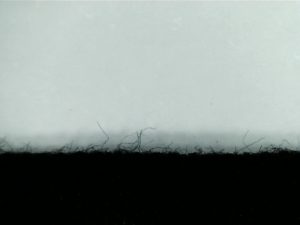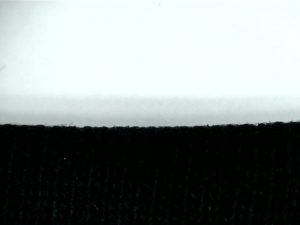In this month’s article Colin Marsh, managing director of Resolute DTG, explores fibres and fibrillation. He will detail the most common types of related problems and how to combat them.
When printing a T shirt with any DTG process the surface you print onto will determine the end result. Fibres and fibrillation can cause a range of quality issues, some not visible to the naked eye until the garments are washed. The two (fibres and fibrillation) must not be confused as they give different results.
Fibres
Let’s start with the symptoms made by fibres. The picture shows the fibres showing in the image that would not be visible before printing. This is common when the actual cotton fibre has snapped in the manufacture process and is allowed to pop up. DTG ink is very thin so the fibres sticking up will not be pushed down by the white ink and actually shows up worse after the CMYK ink has been printed on top of the white.

When printing with white ink certain methods of pre-treatment are better at dealing with fibres than others. The before and after pictures show the surface fibres standing up, after pre-treatment they no longer show and the fabric will now print correctly.


In order to achieve this, the following procedure should help on any DTG system.
- Pre-press the garment for approximately 20 seconds before pre-treating.
- Use medium pressure and a clean sheet of silicone paper.
- Now pre-treat the garment and immediately press again for approximately 30 seconds.
- The pre-treatment must be dry before removing the silicone paper.
- Check this by sliding the paper off, do not peel or lift upwards.
- If it will not slide off with no resistance it is not dry.
- Now print and cure as normal.
Fibrillation – what is it and what does it do
Stray fibres from the manufacturing process are not part of the complete length of woven cotton. These fibres can get dislodged in the wash cycle and can cause some strange fading or peeling problems. As the fibres dislodge in the wash they fall off and disappear.
Not too much to worry about as there are literally millions of fibres in a single T shirt so the fabric will not be affected by this but the print will. The fibres that fall off also take the ink printed onto them at the same time, this mimics fading of the ink, this is very often not the case.
The print will look faded because the missing fibres are now holes in the print reducing the visual density of the image. Combating this kind of fibrillation is again dependant on the pre-treatment process and the type of solution and process used.

- Pre-press the garment for approximately 20 seconds before pre-treating.
- Use medium pressure and a clean sheet of silicone paper.
- Now pre-treat the garment with 50% the normal amount, press again for approximately 20 seconds.
- The pre-treatment must be dry before removing the silicone paper.
- Check this by sliding the paper off, do not peel or lift upwards.
- Repeat the above process.
- The pre-treatment must be dry before removing the silicone paper.
- Check this by sliding the paper off, do not peel or lift upwards.
- If it will not slide off with no resistance it is not dry.
- Now print and cure as normal.
Splitting the pre-treatment process into two applications allows the second application to bind the already coated loose fibres to the rest of the cotton strands. This obviously takes a little longer but allows cheaper shirts to be used at the same time as generating better wash results and longevity for the print.
 Printwear & Promotion The Total Promotional Package
Printwear & Promotion The Total Promotional Package




